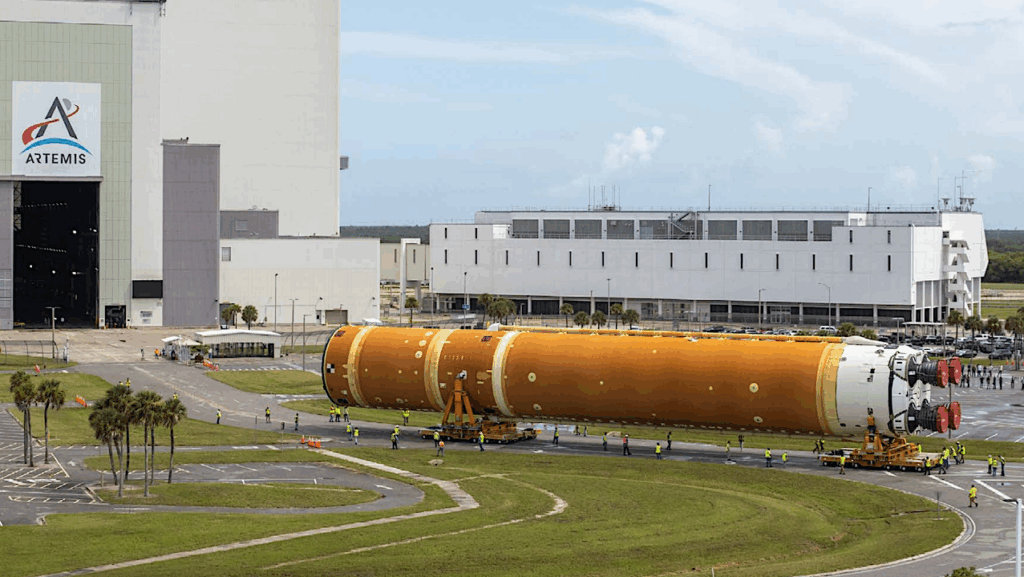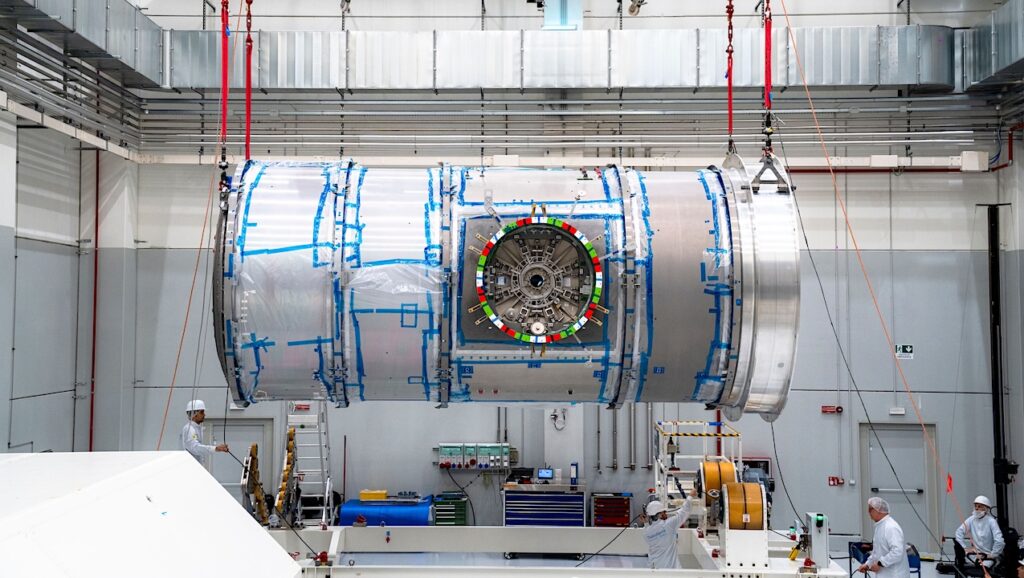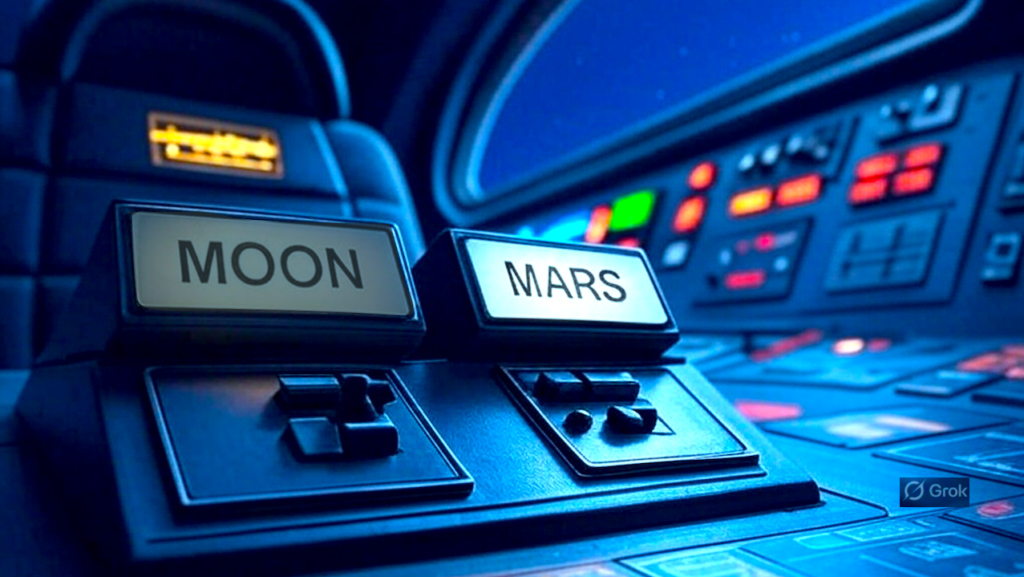Friday's NASA Lunar Lander Event Stirs Up Some Dust (Update)

NASA Administrator to Discuss Human Lander Update for Artemis Program
“NASA Administrator Jim Bridenstine, joined by U.S. Representatives Mo Brooks, Robert Aderholt, Scott DesJarlais and Brian Babin, will discuss updates on the agency’s plans for landing humans on the Moon by 2024 through the Artemis program at 3:10 p.m. EDT Friday, Aug. 16. The remarks will air live on NASA Television and the agency’s website.”
Alabama space center will manage NASA’s lunar lander program, Ars Technica
“As part of the carefully negotiated agreement, Marshall will have responsibility for the overall program as well as two elements of what is planned to be a three-stage lander. The center in northern Alabama will oversee commercial development of the Transfer Element–planned to ferry the lander from the Lunar Gateway down to low-lunar orbit–as well as the Descent Element that will fly down to the surface. … Meanwhile, the Houston, Texas-based Johnson Space Center will oversee development of the Ascent Element. “
This article needs correction. The Johnson Space Center has lost NO ground in its Congressional representation. JSC is managing ISS, Gateway, Orion, Lunar Spacesuits, Mission Control, CLPS & much more. The Lunar Ascent Module could be next. Tune in Friday. https://t.co/I2J1i4jnMc
— Jim Bridenstine (@JimBridenstine) August 14, 2019
Letter To NASA Administrator Bridenstine From Texas Congressional Delegation Regarding Artemis Lunar Lander
“We are writing to you today in light of a recent report that this Friday, August 16,2019, you plan to announce that the Marshall Space Flight Center in Huntsville, Alabama will manage the development of the lunar lander for the Artemis program and oversee the commercial development of two of the three elements, the Transfer Element and Descent Element, of that lander. According to that same report the Johnson Space Center, in Houston, Texas, will oversee the commercial development of only one of three elements, the Ascent Element. This is very troubling if accurate. … we request that you reconsider this decision, and hold off on any formal announcements until we receive a briefing on this matter that includes the timeline, projected cost, and rational for this decision.”
Cruz, Cornyn, Babin Call On NASA to Award Lunar Lander Program to Johnson Space Center
“In response to a news report that NASA will designate the Marshall Space Flight Center in Huntsville, Alabama, to lead the development of the human-classed lunar lander for the Artemis program over the Johnson Space Center in Houston, Texas – which has served as NASA’s lead center for human spaceflight for more than half a century – U.S. Sens. Ted Cruz (R-Texas) and John Cornyn (R-Texas) along with Rep. Brian Babin (R-Texas) today urged NASA Administrator Jim Bridenstine to reconsider his decision and refrain from an official announcement until an official briefing is held.”
 Keith’s note: Reader’s guide
Keith’s note: Reader’s guide
1. NASA announced a lunar lander update event at MSFC with members of Congress. 2. Ars Technica reported details of what will be in that announcement i.e. shared development between JSC and MSFC
3. NASA Administrator disputed accuracy of Ars Technica Story.
4. Members of Congress saw Ars Technica story and are concerned that Texas may not get the lunar lander program – as they told NASA they wanted.
 Keith’s Update: Rep. Babin has pulled out of the event.
Keith’s Update: Rep. Babin has pulled out of the event.
Pertinent to Lunar Lander: "Congressman Babin will not be in attendance today at Marshall Space Flight Center. When or if Administrator Bridenstine makes an announcement regarding the Artemis lunar lander program, Congressman Babin will be ready to provide an official statement."
— Eric Berger (@SciGuySpace) August 16, 2019
Statement by Rep. Brian Babin Regarding NASA’s Decision To Award Lunar Lander Program Management to Marshall Space Flight Center
“I am disappointed by the decision from NASA to not place the lunar lander program management at the Johnson Space Center (JSC),” said Babin. “Marshall Space Flight Center does tremendous work for our nation’s space program, but the knowledge base and skill set for this task unquestionably resides at JSC where the Apollo lunar lander program was successfully managed.”









Politicians have to politic.
As long as Bridenstine’s next announcement he is putting Nick Saban in charge of Artemis, I’m good.
Roll Tide!
Since Nick is a transplanted West Virginian in Alabama (like, I don’t know, somebody else), I think he would be an excellent choice. We could definitely do worse (and have).
That’s odd. Not that congressmen are arguing about which centers in whose districts get what. I’d expect that. But I just looked up the Representatives listed for tomorrow’s meeting. Two from northern Alabama, one from southern Tennessee (i.e. the districts within commuting distance of Marshall) and Brian Babin, also quite reasonable since he chairs the Committee on Science, Space and Technology’s Space subcommittee (as well as representing the district in Texas which contains Johnson.)
But Mr. Babin also signed the letter complaining about the Ars Technica story. I’d think he’d know what Mr. Bridenstine was going to announce while he was standing next to him on the podium. And I think Mr. Bridenstine has more common sense than to surprise Mr. Babin by saying anything unexpected. I’d say this is either a major communications oops or the Ars Technica story is wrong (rare for Mr. Berger.) It will be interesting to see how the dust settles.
You won’t Sir. NASA is such a small percentage of the budget you won’t see a fight. It isn’t worth it. Moreover, as compared to the defense budget, NASA funds are not even icing on the cake. It is more like Yellow colored writing icing on the top of the icing on the cake… You just don’t care what color it is.
Whether the contracts go to Marshall or Johnson matters very much to the congressmen who represent the people who work there. That’s probably all of five or six of them, for a wapping 1.1 to 1.4% of the House of Representatives. Since the remaining >98% of them basically don’t care, those half-dozen people are the ones who matter.
Districts without NASA interests care much less about it. The 98% just do not care about .42 of the budget that is directed to NASA (2012 dollars)
When is there not trouble and misscommunication in paradise.
I think both JSC and MSFC have done fairly lousy jobs managing programs in recent years. Maybe they’d be better off giving the lander to JPL or to Musk’s Space X? They’ve been doing far better in recent years.
NASAs management of human space is a joke-has been for a long time. No one is going anywhere anytime soon if either JSC or MSFC are running the show.
Says who?
If you look at what APL has gotten in recent years, that gives me some pause when you mention JPL. Just saying.
APL has done some nice work. They are expensive, but they have a reasonably good reputation for staying within that budget. But they’ve never landed anything on an extraterrestrial body. Other than JPL, no one in the United States has, at least not since 1972. (I consider NEAR and OSIRIS-REx to be dockings, not landings, given the gravity of those asteroids.) It isn’t obvious how relevant robotic Mars landers are to Moon landers carrying astronauts, but… On the other hand, I don’t think JPL has much experience with multi-spacecraft missions or docking them in orbit.
“Other than JPL, no one in the United States has, at least not since 1972.”
NASA Ames, Pioneer Venus 1978… ok, it wasn’t by design, but one of the probes continued to transmit for 1/2 hour after landing (impact). 😉
Ok. On a related note, the project scientist for the ESA Rosetta mission claimed the first _three_ landings on a comet, based on the Philae lander bouncing a couple times…
Lets clear up a myth here that JPL would do a better job managing a large project (a Human one at that). And since you didn’t list GSFC do we even need to bother with that and JWST?
So Space X, lets consider that (and I am a big supporter of their can do, get it done, affordable mentality) this is a Human Lander and they built a heck of a rocket in the Falcon 9, but we really don’t know yet if we have a successful commercial crew Space X vehicle yet and this is a whole other level of hard from a capsule (albeit similar hard for the boosters landing which is impressive — just remember NONE of those boosters could fail, 100 percent success required). Also, Space X might do a good job on Cost, but schedule performance more questionable. And at some point, schedule delays cause cost problems. Also, schedule delays are a big issue if we are supposed to land on the Moon in 2024?
Personally I think NASA is surely part of the blame (sometimes bureaucracy, sometimes individuals, etc), but the primes have to be heavily responsible for the poor performance of large programs. If we should have a major issue it is that award fees are given for such poor performance and you can be sure there is a lot more to that story than NASA Civil Servants thinking they should not give award fee and getting overruled..
Boeing has a doozy list of overruns, Lockheed, NG, the list goes on. Whether managed by NASA, DOD, or even DARPA for that matter, govt acquisition, requirements process, oversight, and prime performance is broken across the board. Show me the “DODwatch” page, it doesn’t exist (well maybe its the Washington Post), but if it did it would be covered with the same HUGE issues.
One area where NASA has been managing very well is Discovery/New Frontiers/Explorers etc. Less than 1 Billion dollar missions. By the way MSFC manages D/NF with a light touch but stringent review process. Anyway, just not a fan of a flippant comment that JSC/MSFC bad and JPL/Space X good. This is a much more complex debate. Unless you personally have managed an ACAT 1D or Flagship NASA Mission, etc., within cost and schedule, not sure people have room to talk about a better way to manage programs. (P.S. one of the most successful, on cost, schedule, and well managed missions in all of NASA’s history by the way was Chandra, Fred Wojtalik was the PM in the 90s, launched in 98).
So agree that JSC and MSFC have done fairly poor jobs managing fairly poor Prime contractors in recent years, but disagree that JPL(plenty of data) and even Space X(not enough data) could do far better managing a Human Lander.
JPL
MARS 2020
Today NASA confirmed persistent rumors that the Mars 2020 project is in trouble. Buried in the agency’s FY2020 detailed budget justification book, released by OMB and the Government Publishing Office this morning, the agency reveals that two of the instruments and the sample caching system “have resulted in mission cost growth.” A NASA official told a planetary science conference this evening that the overrun is about 15 percent. [AND THIS HAS NOT LAUNCHED YET FOLKS, More to come]
Curiosity
By November 2008 most hardware and software development was complete, and testing continued.[82] At this point, cost overruns were approximately $400 million. In the attempts to meet the launch date, several instruments and a cache for samples were removed and other instruments and cameras were simplified to simplify testing and integration of the rover.[83][84] The next month, NASA delayed the launch to late 2011 because of inadequate testing time.[85][86][87] Eventually the costs for developing the rover reached $2.47 billion, that for a rover that initially had been classified as a medium-cost mission with a maximum budget of $650 million, yet NASA still had to ask for an additional $82 million to meet the planned November launch. As of 2012, the project suffered an 84 percent overrun.[88]
SMAP
Mission managers for NASA’s Soil Moisture Active Passive (SMAP) observatory have determined that its radar, one of the satellite’s two science instruments, can no longer return data. However, the mission, which was launched in January to map global soil moisture and detect whether soils are frozen or thawed, continues to produce high-quality science measurements supporting SMAP’s objectives with its radiometer instrument.
NASA launched SMAP in 2015 at a cost of $915 million to build, launch and
First of all, anyone who says “100 percent success required” should be disqualified from managing any engineering project. That is not possible, and thinking it is simply demonstrates incompetence.
Second, saying MSFC manages the Discovery and New Frontiers programs is very misleading. They do not manage the individual missions. The program officials at NASA headquarters are responsible for a fair fraction of that review process. MSFC basically handles the contractual paperwork, makes sure deliverables are, well, delivered, that the right reviews are schedules in the right order, and in general making sure someone _else_ is managing the missions in the way NASA approves of.
And, while I’m no fan of JPL, the numbers your source gives for Curiosity don’t add up. How can it be $2.47 billion at the time of launch, originally “classified” as a medium-cost mission with a maximum budget of $650 million, and 84% over budget? $2.47 billion is not 184% of $650 million. Nor was there ever a $650 million cost cap. In reality, something vaguely like Curiosity was sold to a planetary Decadal Study based on an unsubstantiated and unreviewed claim it would cost $650 million. Formally, NASA doesn’t count cost growth until the end of Phase B (with Preliminary Design Review and Key Decision Point C.) That’s when the design is considered mature enough for a reliable cost estimate. By the time Curiosity got there, it was already at about one and a quarter billion (which is where that 84% comes from.) That was because (1) the original $650 million claim was completely wrong and (2) lots of requirements growth, to the point where Curiosity was much more ambitious than what the Decadal Survey identified as a top priority. JPL was certainly responsible for a large part of that, but so were the Project Science Group and the relevant people at NASA Headquarters.
In point of fact, I don’t think any NASA center (or JPL) has what you’d call a stellar track record when it comes to cost and budget of a flight mission. Every one has run some projects well, and turned some into complete disasters. (I should exempt Ames and Langley from that, since they haven’t done many spacecraft missions recently, and I’m not as familiar with them.) But one thing you can say about JPL (and Lockheed Martin and SpaceX) is that they’ve landed rockets on planetary surfaces. And done so more recently than 46 years ago.
Shouldn’t all these senators and congressman make sure the agency gets the $1.6B funding request first before they worry about who may or may not be managing a lander program that can’t take off if there is no money to pay the commercial companies to build it. How much longer is appendix H going to slip to the right cause the money isn’t there and folks are worried about the org chart. Last I checked 2024 by any means necessary doesn’t include adding more days on the calendar between now and then to waste time on petty fiefdom battles. Are we all in on the mission to the moon or not? Money first then stand up the org with the right people regardless of center to get the job done.
Three stage??? Gee, lets make this as complicated as possible….
So the first stage transfers stages 2 and 3 from gateway to LLO, the second stage lands stage 3. Ascent is handled by stage 3.
So they are stuck in LLO… or did someone forget stage 4??? https://media2.giphy.com/me…
Ascent element is supposed to have enough prop for surface to nrho burns including potentially anytime abort which can be quite expensive given 7 day period of gateway
Some of the concepts people have discussed to that, but not all of them. I don’t think that’s a definite requirement at this point. (On the other hand, I’m typing this 67 minutes before the requirements may become much more definite.)
This is an important point, there can be efficiencies from the three-part lander design since only the ascent phase is likely to have human rating requirements if it it also serves as the abort element. And JSC got the ascent phase.
No inside knowledge here – this was addressed at a public meeting in 2018:
https://spacenews.com/nasa-…
It needs to be three stages because of the stupid high NRHO orbit around the moon that Gateway will be in. And Gateway will be in that stupid high orbit because Orion’s service module lacks the delta-V to put it into (and out of) a low lunar orbit like Apollo used.
Most of the issues with Artemis can be directly traced back to SLS/Orion, IMHO.
Then increase the capacity of the service modules fuel tanks so it has more delta-V.
Or would that make it to heavy for SLS?
That’s not going to happen. Orion has been under development for what seems like forever. No way NASA would make such a fundamental change so late in the game. At this point, they’ve been building flight hardware. Development is pretty much done at this point.
Maybe not. The first three service module’s main engines are going to be Space Shuttle surplus (AJ-10s from the Orbital Maneuvering System.) There is a potential for some redesign after the first three missions. On the other hand, Artemis 3 is supposed to be the landing, so that might only apply to the longer-term (2028 and later) “sustainable” architecture.
We can call the three stages, Larry, Curly and Mo.
What is wrong with a simple two stage design like the LEM? Oh, that is right, the SLS, being less capable than the Saturn V, is unable to deliver it to the Moon with the Orion. It would take two launches to do it.
Our European friends have demonstrated just how effective this management approach can be.
Honestly, the entire architecture, from SLS to Gateway and now a three stage lander is absolutely ridiculous. All joking aside, it appears that a lot of people have forgotten that complexity is not your friend particularly in highly dynamic environments.
Even if it isn’t a dynamic environment, multiplying interfaces is always a mistake. I’ve seen flight instruments with subsystems provided by multiple institutions, and getting those different pieces to work together properly is a real problem.
Completely agree!
I think the ascent stage would dock with the transfer vehicle in low lunar orbit. Then the transfer vehicle takes the astronauts (and perhaps the ascent stage) back to Gateway. But I really don’t think we’re talking about a very mature concept. I’m reminded of a Cassini PI who had kept a drawing of the notional spacecraft from the original AO. There was virtually no resemblance to the spacecraft they eventually flew.
I searched high and low for the transfer vehicle concept and the only thing I could find was a small image on that notional plan released a few months ago.
They seem to be hell bent on it because they can’t get a 50 ton lander to lunar orbit. And they got to have a 50 ton lander because a 49 ton just won’t do.
I think this was really how Gerst ran things (always to increasing complexity) and is the reason he had to go.
Gateway, transfer vehicle, descent vehicle, ascent vehicle.
At some point someone at NASA had to have exclaimed “WTF are we doing?!”
This is one of those ‘fly on the wall moments’, for sure.
I’d figure the Mr. Bridenstine would gather the troops. A thoughtful consideration of the Agenda would ensue.
Mr. Bridenstine would have already assigned homework to all participants. They would have a head start, and would be ready to engage! Participants, all eager to contribute, appear early, coffee in hand.
The homework assignment would be something like this:
1. Provide, in tabular form, the technical requirements in the management of the aforementioned Lander;
2. Provide similarly the project management requirements;
3. Rank the requirements in #1 and #2 above, from highest to lowest;
4. Provide, in tabular form, the technical and management abilities of the relevant NASA center;
5. Rank the technical and management abilities of the relevant NASA centers.
Some problems just solve themselves.
They actually have a very detailed process for making those decisions as part of the Acquisition Strategy which includes much of what you describe, and presenting to the Agency PMC for decisions. Whether that was followed, don’t know.
Sometimes I wonder if programs get very big, they go beyond what people can manage. Exception of Apollo though spent a lot of money it did deliver on schedule. Of course there’s lots of debate on NASA spending, low handing fruit for OMB I guess which is noticably silent of expenses of mideast wars.
The bigger a program is, the harder it’s going to be to manage. Or, I guess more correctly, the more complex it is. It ends up taking more managers and more levels of management. There are more things to keep track of and that workload needs to be spread around. But more levels of management hurts clear communications between the people doing the actual work and the people making the high-level decisions. And, management aside, lots of bad things happen when a program becomes too big to fail.
I just realized why this whole thing, as described in Ars Technica, is making me uncomfortable. Having one overall office for program management, and three offices to manage the commercial contracts for three elements, seems like overkill. If the design and development is done commercially, like commercial cargo or crew to the space station, then it’s very management heavy. It’s almost as if they’re expecting Marshal and Johnson to have a much more active role in design and development. Something more along the lines of contracting to Lockheed Martin to build Orion.